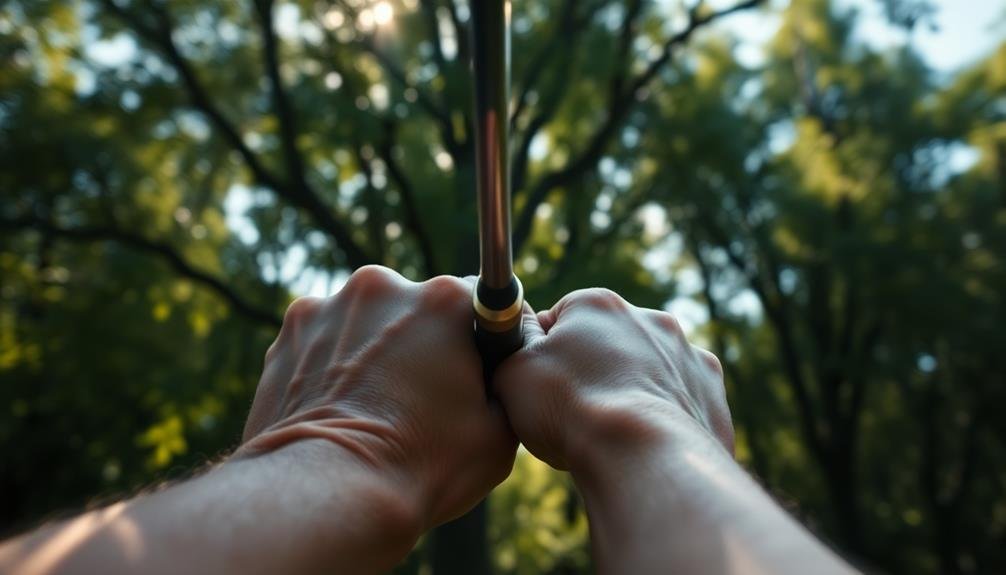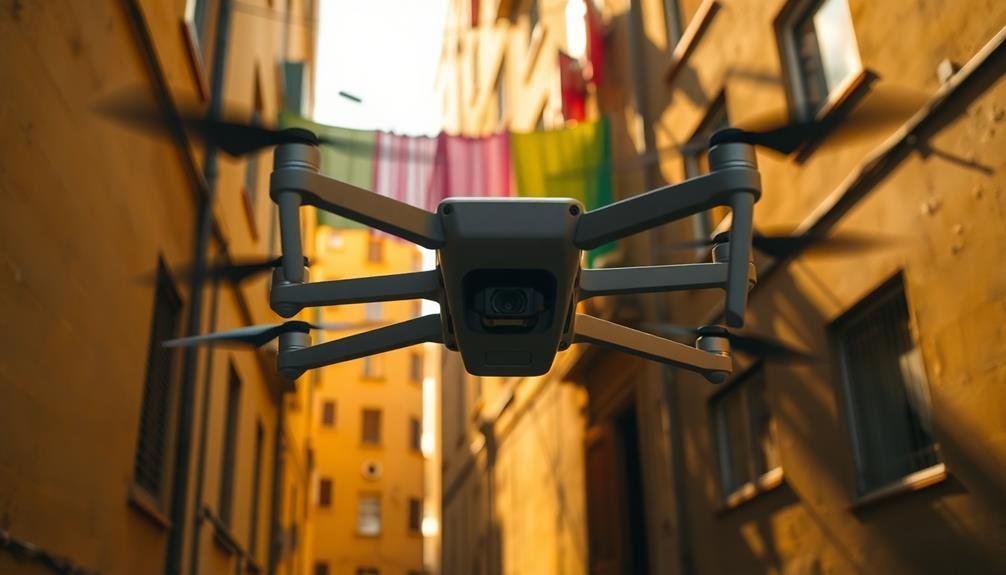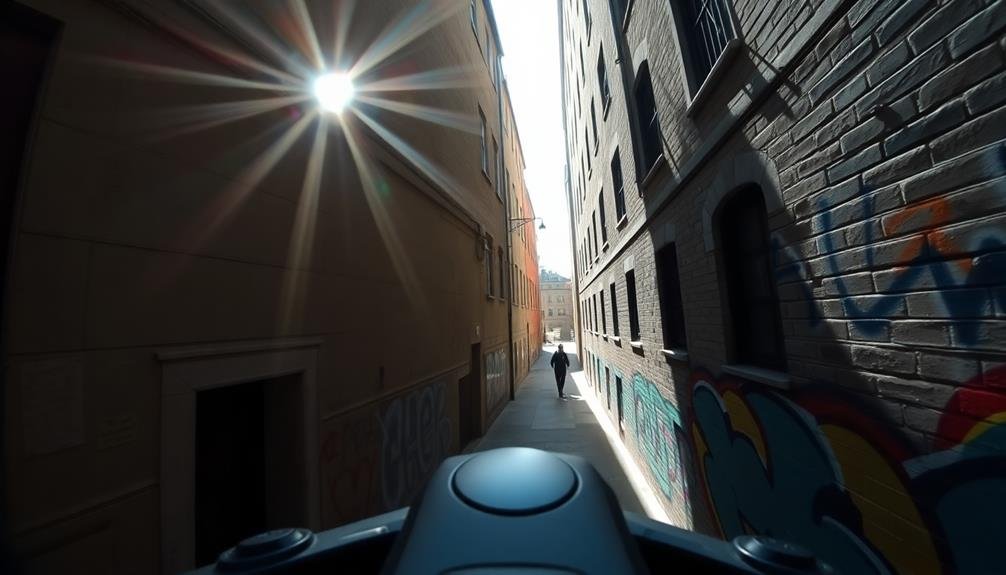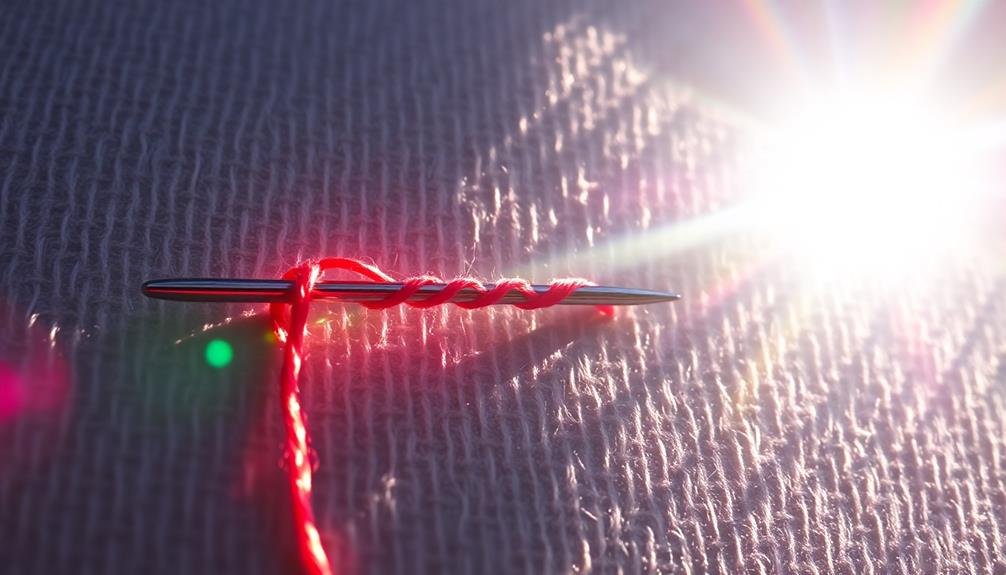To master tight-space shots, start by developing precise control techniques and a delicate touch. Choose a smaller drone for better maneuverability in confined areas. Carefully plan your flight path, considering obstacles and entry points. Utilize FPV for enhanced situational awareness and improved depth perception. Optimize your camera settings for movement, focusing on faster shutter speeds and continuous autofocus. Practice with simulated obstacles to build confidence and skill. Finally, make the most of natural light, using windows as softboxes and playing with shadows for depth. These tips will help you thread the needle and capture stunning images in challenging environments. Dive deeper to reveal even more advanced techniques.
Master Precision Control Techniques

For tight-space shots, mastering precision control techniques is vital. You'll need to develop a delicate touch and unwavering focus to execute these challenging shots successfully.
Start by practicing your grip; a relaxed hold allows for better control and feel. Experiment with different grip pressures to find the sweet spot that gives you ideal control without tension.
Next, work on your stance. A stable base is essential for precision shots. Keep your feet shoulder-width apart and distribute your weight evenly. Engage your core muscles to maintain balance throughout the shot.
Practice making small, controlled movements with your upper body while keeping your lower body still.
Pay close attention to your backswing and follow-through. In tight spaces, you'll need to shorten your backswing and focus on a compact, controlled motion. Keep your wrists firm and use your shoulders to guide the club.
On the follow-through, maintain a smooth, abbreviated motion to avoid hitting nearby obstacles.
Lastly, train your eye-hand coordination. Use alignment aids during practice to improve your ability to aim accurately in confined spaces.
With consistent practice, you'll develop the muscle memory and confidence needed to thread the needle in tight spots.
Choose the Right Drone Size

How does drone size impact your ability to navigate tight spaces? It's essential to understand that smaller drones are generally more maneuverable in confined areas. A compact drone can easily slip through narrow gaps and around obstacles that would challenge larger models.
When choosing a drone for tight-space shots, consider mini or micro drones. These lightweight options offer excellent agility and can often fit in the palm of your hand. They're ideal for indoor flights or outdoor locations with limited clearance.
However, don't sacrifice image quality for size. Look for small drones that still pack a punch regarding camera capabilities.
For slightly more open but still confined spaces, mid-sized drones might be suitable. They offer a balance between maneuverability and advanced features. Consider foldable drones, which can be compact for transport but expand for flight.
Plan Your Flight Path Carefully

Before launching your drone into a tight space, carefully plan your flight path. Visualize the route you'll take, considering obstacles, entry and exit points, and potential hazards. Pay attention to wind patterns and air currents, which can considerably affect your drone's movement in confined areas.
Start by identifying your shot's focal point and work backwards to determine the best approach. Use landmarks or reference points to guide your flight, and consider marking key positions with visual aids if possible. Practice the planned route in an open area first to familiarize yourself with the movements and timing.
Break down complex maneuvers into smaller, manageable segments. This approach allows you to focus on executing each part precisely. Don't forget to plan for contingencies, such as unexpected obstacles or equipment malfunctions. Have a clear exit strategy in mind at all times.
Utilize your drone's intelligent flight modes if available, such as waypoint navigation or point of interest, to create smooth and predictable movements. However, be prepared to switch to manual control if needed.
Utilize FPV for Better Awareness

When flying in tight spaces, using First Person View (FPV) can dramatically improve your situational awareness.
You'll gain enhanced spatial perception, allowing you to better judge distances and angles in real-time.
This increased awareness enables you to react quickly and avoid obstacles as they appear, making your tight-space shots more successful and safer.
Enhanced Spatial Perception
As you navigate tight spaces, first-person view (FPV) becomes an invaluable tool for enhancing your spatial perception. This immersive perspective allows you to see exactly what your drone sees, giving you a more accurate sense of depth and distance.
You'll be able to judge clearances more precisely, reducing the risk of collisions in confined areas.
To maximize the benefits of FPV, focus on developing your depth perception skills. Practice estimating distances between objects in your field of view and compare them to actual measurements. This will help you build a more accurate mental map of your surroundings.
Pay attention to visual cues like shadows, reflections, and object size changes as you move through the space.
Use the FPV feed to identify potential obstacles that mightn't be visible from your ground position. Look for subtle changes in lighting or texture that could indicate protruding objects or uneven surfaces.
Real-Time Obstacle Avoidance
Real-time obstacle avoidance becomes essential when maneuvering tight spaces with your drone. First-Person View (FPV) technology greatly enhances your ability to navigate these challenging environments. By providing a live feed from your drone's perspective, FPV allows you to make split-second decisions and react to obstacles as they appear.
When using FPV for tight-space shots, focus on the edges of your frame. This technique helps you maintain awareness of potential obstacles entering your flight path. Pay close attention to shadows and changes in lighting, as they can indicate upcoming obstructions.
Utilize your drone's obstacle avoidance sensors in conjunction with FPV for an added layer of safety. However, don't rely solely on these sensors, as they may have limitations in complex environments. Instead, use them as a backup to your visual observations.
Practice flying through simulated tight spaces before attempting challenging shots. This will help you develop muscle memory and improve your reaction time.
Remember to adjust your drone's settings for the best performance in confined areas, such as reducing maximum speed and increasing control sensitivity.
Optimize Camera Settings for Movement

Dialing in your camera settings can make or break a tight-space shot with movement. Start by setting your shutter speed high enough to freeze motion, typically 1/250th of a second or faster. This will help prevent blur from camera shake or subject movement.
Boost your ISO to compensate for the faster shutter speed, especially in dimly lit spaces. Don't be afraid to push it to 1600 or higher if necessary.
Choose a wider aperture (lower f-number) to let in more light and create a shallower depth of field. This can help separate your subject from the background in cramped quarters.
Set your camera to continuous autofocus (AF-C) mode to track moving subjects. Select a focus point that corresponds to where you anticipate your subject will be.
Consider using burst mode to capture multiple frames in quick succession. This increases your chances of getting the perfect shot as your subject moves through tight spaces.
If possible, enable image stabilization to further reduce camera shake. Finally, shoot in RAW format to give yourself more flexibility in post-processing, allowing you to recover details from shadows or highlights in challenging lighting conditions.
Practice With Simulated Obstacles

Several photographers overlook the value of practicing tight-space shots in a controlled environment. Yet, simulating obstacles can greatly improve your skills before facing real-world challenges.
Start by creating a makeshift obstacle course in your home or studio. Use everyday objects like chairs, boxes, or plants to mimic tight spaces you'll encounter on location.
Set up your camera and move through the course, experimenting with different angles and compositions. Practice maneuvering your body and equipment in confined spaces without bumping into objects. This will help you develop muscle memory and spatial awareness, essential for maneuvering tight spots during actual shoots.
Gradually increase the difficulty by narrowing passages or adding more obstacles. Try shooting while crouching, kneeling, or even lying down to simulate various scenarios.
Don't forget to practice with different lenses, as their focal lengths will affect your approach in tight spaces.
As you become more comfortable, introduce moving elements to your course. Have a friend walk through the obstacles while you attempt to capture them. This will sharpen your reflexes and timing, preparing you for dynamic tight-space situations in the field.
Exploit Natural Light and Shadows

When shooting in tight spaces, you'll often find natural light your best ally.
Window light techniques can create depth and dimension, helping to make confined areas appear more spacious.
Don't overlook the power of shadow play strategies, which can add drama and intrigue to your tight-space compositions.
Window Light Techniques
Through the clever use of window light, you can transform tight spaces into dynamic shooting environments. Windows act as natural softboxes, diffusing harsh sunlight and creating a flattering glow.
Position your subject near a window, experimenting with different angles to achieve the desired effect. For portraits, side lighting can add depth and drama, while front lighting offers a softer, more even illumination.
Don't be afraid to manipulate window light to suit your needs. Use curtains or blinds to control the intensity and direction of light. Reflectors can bounce light back onto your subject, filling in shadows and balancing exposure.
In extremely tight spaces, you can even use a window as your backdrop, creating a high-key effect.
Consider these window light techniques to enhance your tight-space photography:
- Use sheer curtains to soften harsh sunlight
- Position subjects at a 45-degree angle to the window for dimensional lighting
- Experiment with backlighting for a dreamy, ethereal effect
- Utilize window frames to create natural framing within your composition
- Combine window light with artificial light sources for more control
Shadow Play Strategies
Shadow play can transform tight spaces into enchanting visual landscapes. By strategically using light and shadow, you'll create depth and intrigue in your confined compositions. Look for natural light sources like windows or doorways, and position your subject to interact with the resulting shadows.
Experiment with different times of day to capture varied shadow patterns. Early morning or late afternoon light can cast long, dramatic shadows that add visual interest. Don't shy away from harsh midday light; it can create bold, graphic shapes perfect for high-contrast shots.
Use props or architectural elements to manipulate shadows. A lace curtain or patterned screen can cast intricate shadows, while a simple blind can create striking lines across your frame.
| Shadow Type | Effect | Best Time |
|---|---|---|
| Soft Edges | Dreamy | Overcast |
| Hard Edges | Dramatic | Sunny |
| Dappled | Textured | Filtered |
Frequently Asked Questions
How Can I Improve Battery Life When Flying in Tight Spaces?
You can improve battery life in tight spaces by reducing your flight speed, minimizing rapid movements, using efficient flight modes, and avoiding constant altitude changes. Also, consider using lighter payloads and removing unnecessary accessories from your drone.
What Are the Legal Restrictions for Flying Drones in Confined Areas?
You'll need to check local regulations, as laws vary. Generally, you can't fly in restricted airspace, near airports, or over people. Always get permission from property owners and maintain visual line of sight with your drone.
Which Drone Brands Are Best Suited for Tight-Space Photography?
For tight-space photography, you'll want to contemplate DJI's Mini series, Autel's Nano drones, or Parrot's ANAFI. They're compact, agile, and offer excellent camera quality. Don't forget to check their obstacle avoidance features for safer flying.
How Do Weather Conditions Affect Tight-Space Drone Shots?
Weather greatly impacts your tight-space drone shots. Wind can make maneuvering tricky, while rain affects visibility and camera performance. Low light conditions may require longer exposures. You'll need to adjust your settings and flying techniques accordingly.
What Safety Precautions Should I Take When Flying in Narrow Environments?
When flying in narrow environments, you'll need to prioritize safety. Always use propeller guards, maintain visual line of sight, fly slowly, and practice in open spaces first. Don't forget to check for obstacles and wind conditions.
In Summary
You've now got the tools to tackle those tricky tight-space shots. Remember, it's all about control, preparation, and practice. Don't be afraid to start small and work your way up to more challenging spaces. With time, you'll develop the confidence and skill to thread your drone through even the tightest gaps. Keep pushing your limits, and you'll soon be capturing breathtaking footage that'll leave viewers wondering how you pulled it off.

As educators and advocates for responsible drone use, we’re committed to sharing our knowledge and expertise with aspiring aerial photographers.




Leave a Reply